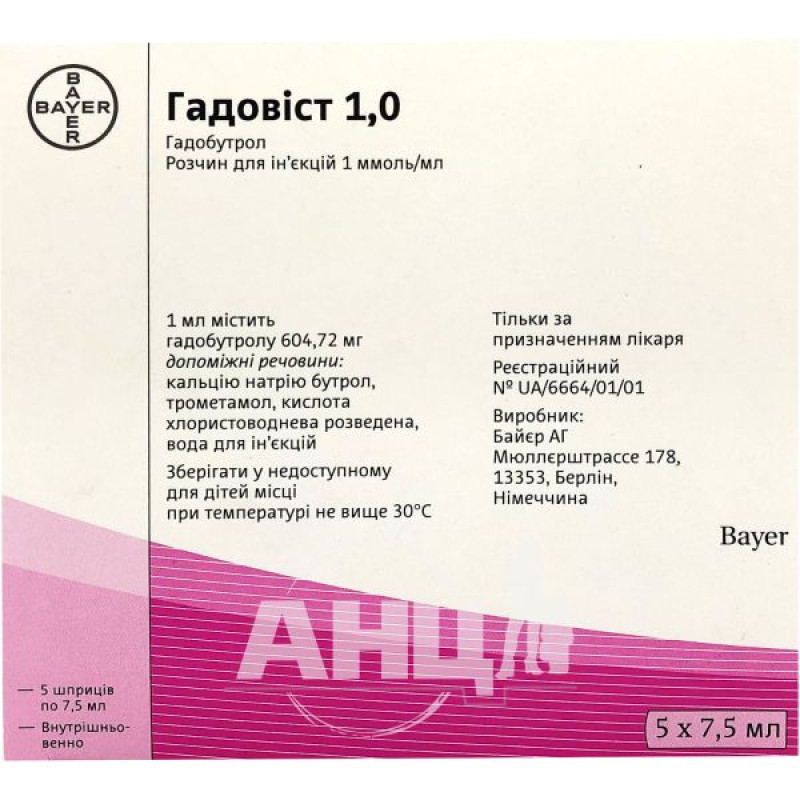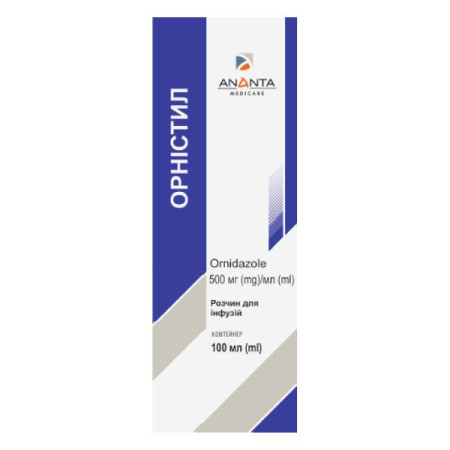Gadovist 1.0 solution for injection 1 mmol/ml syringe 10 ml No. 5

Pharmacological properties
Paramagnetic contrast agent intended for enhancing image contrast during magnetic resonance imaging (MRI). The contrast-enhancing effect is achieved due to the properties of gadobutrol, an electroneutral complex compound consisting of a gadolinium (III) ion and a macrocyclic ligand, which is a derivative of dihydroxy-hydroxymethylpropyl-tetraazacyclododecane-triacetic acid (butrol).
The presence of a large magnetic moment of the gadolinium ion causes fluctuations in the local magnetic field and, as a result, a decrease in the intensity of the magnetic resonance signal on T2-weighted images.
Even low concentrations of gadobutrol lead to a significant reduction in relaxation time. At pH 7.0 and a temperature of 40 °C, the following effect of gadobutrol on the relaxation characteristics of blood plasma water protons is observed: on the spin-lattice relaxation time value - approximately 5.6 l / mmol s and on the spin-spin relaxation time value - 6 , 5 l / mmol s. A weak dependence of the relaxation characteristics on the magnitude of the magnetic field strength is observed.
According to in vivo and in vitro studies, the macrocyclic ligand forms a highly stable complex with the paramagnetic gadolinium ion. Gadobutrol is well soluble in water and has a fairly high hydrophilicity: the solubility coefficient in a mixture of n-butanol and buffer solution at pH 7.6 is of the order of 0.006. When interacting with enzymes, Gadovist cannot show the ability to form bonds with proteins or inhibit enzymes. Gadovist does NOT activate the complement system, does not cause anaphylactic reactions, and does not have a toxic effect on the liver, kidneys, or cardiovascular system.
The use of the drug allows to increase the volume of diagnostic information in comparison with the results of MRI, performed without the introduction of contrast agents. In pathologically altered areas of brain tissue due to inflammatory or demyelinating processes, as well as in areas of localization of primary and metastatic tumors, perfusion changes and the volume of extracellular space increases. In such areas, the blood-brain barrier is broken or absent.
From the body, like other biologically inert highly hydrophilic compounds (mannitol, inulin), Gadobutrol is excreted by the kidneys. After intravenous administration, it is rapidly distributed in the extracellular space. It is excreted mainly by the kidneys by glomerular filtration in unchanged form. It does not penetrate the intact blood-brain barrier. In insignificant quantities, it penetrates the placenta. Approximately 0.01% of the administered dose of the drug is determined in fetal tissue. The concentration in breast milk is insignificant (approximately 0.01% of the administered dose).
When taken orally, it is absorbed slightly.
The pharmacokinetics of gadobutrol is dose-dependent. When gadobutrol is administered at a dose of up to 0.4 mmol/kg, the half-life is on average 1.81 h (1.33-2.13 h). When gadobutrol is administered at a rate of 0.1 mmol/kg, 2 min after administration of the drug, its average concentration in the blood plasma is 0.59 mmol/l, and 1 h after administration - 0.3 mmol/l. 2 h after administration, more than 50%, and 12 h - more than 90% of the administered dose is excreted in the urine. When administered at a dose of 0.1 mmol/kg, Gadobutrol is almost completely excreted 72 hours after injection. In healthy people, the renal clearance of gadobutrol is from 1.1 to 1.7 ml/min. Less than 0.1% is excreted in the feces. No metabolites of gadobutrol were detected in blood plasma or urine.
In patients with impaired renal function, the half-life of the drug increases due to a decrease in the glomerular filtration rate. In patients with mild or moderate renal impairment, the drug is not detected in the urine after 72 hours. In patients with severe renal impairment, at least 80% of the drug is excreted in the urine within 120 hours. It is removed by hemodialysis.
Indication
The drug is intended to increase the contrast of images of the brain and spinal cord during magnetic resonance imaging.
The drug is used for differential diagnosis of intra- and extramedullary tumors, detection of solid tumor areas in previously detected pathologically altered cavities in the spinal cord, as well as for determining the boundaries and sizes of intramedullary tumors.
The 1 mmol/ml solution is particularly indicated in cases requiring high doses of contrast media. For example, when the detection of an additional lesion determines the tactics of further treatment, or for the detection of small areas of pathological tissue changes, as well as areas that do not accumulate contrast media well.
A solution of the drug at a concentration of 1 mmol/ml is also used to determine perfusion for the purpose of diagnosing stroke, detecting focal ischemic brain damage, and also for studying perfusion processes in tumors.
To enhance image contrast during magnetic resonance angiography.
The drug in the recommended doses is administered intravenously as a bolus. Magnetic resonance imaging can be obtained immediately after drug administration (the duration of the time interval between drug administration and the start of data collection is set in accordance with the pulse sequence used and the selected study protocol). Optimal image contrast is noted during the arterial phase of contrast agent accumulation and is approximately 15 minutes after drug administration (the duration of the period required to obtain optimal image contrast depends on the nature of the pathology, the properties of the visualized tissue, including the type of tumor). As a rule, contrast enhancement is observed within 45 minutes after drug administration.
The drug is administered intravenously, with the patient lying down. After administration of the drug, the patient should be under the supervision of medical personnel for at least 30 minutes.
To assess the effectiveness of the use of contrast agents, pulse sequences that allow obtaining a T1-weighted magnetic resonance image are most suitable.
To study brain perfusion processes, it is recommended to use pulse sequences that allow obtaining T2-weighted images.
Clinical trials have shown good tolerability of the drug at a daily dose of up to 1.5 ml/kg.
Adult doses
Doses recommended for brain and spinal cord studies
For diagnosis, it is recommended to administer the drug solution at a dose of 0.1 ml/kg. If, after administration of the drug at the specified dose, the images are not sufficiently informative for a complete picture of the disease, and also if, in the opinion of clinicians, additional information about the number, size and extent of pathologically altered areas of brain or spinal cord tissue is required to develop further treatment tactics, then 30 minutes after the first administration of the drug, an additional administration of 0.1-0.2 ml/kg is allowed. The diagnostic value of the study may be increased by administering the drug at a dose of 0.3 ml/kg, for example, if it is necessary to exclude metastases or recurrent tumors. This applies to focal lesions of the brain or spinal cord tissue, characterized by reduced vascularization or a decrease in the volume of extracellular space. An increase in the dose of the drug may also be recommended if pulse sequences that do not provide strong T 1 weighting are used to obtain images.
To study the processes of cerebral perfusion, pulse sequences are recommended, allowing to obtain images weighted by T 2. These studies with the use of the drug Gadovist are also effective if it is necessary to confirm or exclude the presence of volumetric formations, as well as to detect ischemic foci in the brain and spinal cord tissue, which are associated with the tumor process. In such studies, the use of an injector is recommended for the administration of the drug at a dose of 0.3 ml/kg; the rate of administration of the solution is 3-5 ml/s.
To obtain an image for one field of view, 7.5 ml of the drug is required for patients weighing less than 75 kg and 10 ml of the drug for patients weighing 75 kg or more. This dose corresponds to 0.1-0.15 mmol/kg.
To obtain images with multiple fields of view, 15 ml of the drug is required for a body weight of less than 75 kg and 20 ml for a body weight of 75 kg or more. This dose corresponds to 0.2-0.3 mmol/kg.
The efficacy and safety of the drug in studies of patients under the age of 18 have not yet been established.
Contraindication
Hypersensitivity to the components of the drug.
Side effects
Nausea and vomiting are possible, therefore, 2 hours before the examination, the patient is recommended to refrain from eating, which minimizes the risk of vomiting and aspiration of vomit. In rare cases, anaphylactoid reactions may occur, accompanied by shortness of breath and other symptoms, up to anaphylactic shock. In rare cases, allergic reactions have been observed after the administration of Gadovist. A short-term feeling of cold, warmth or pain (from mild to severe) may appear at the site of administration of the drug. There are reports that sometimes the administration of the drug was accompanied by nausea and vomiting. During or immediately after the bolus administration of the drug, unusual taste or smell sensations may occur.
Vasodilation and decreased blood pressure have also been observed. Transient diffuse headache and dizziness have been reported occasionally.
Extravasation of the drug may cause a sensation of pain in the tissue adjacent to the injection site for several minutes. No other skin reactions have been reported.
There are reports of the following side effects associated with the administration of drugs similar to Gadovist: convulsions, chills and loss of consciousness; at present, a causal relationship between these events has not been established.
There are reports of anaphylactoid reactions observed with similar drugs, so the possibility of developing similar reactions also exists with Gadovist. During the study, appropriate drugs and equipment for emergency care (endotracheal tube, ventilator) should be available. When examining patients with a history of allergic reactions, the decision to use Gadovist should be made only taking into account the prevalence of the benefits of using the drug over the risks associated with its use.
The use of contrast agents can cause long-term negative effects (hours or days after administration of the drug).
To date, there have been no reports that the administration of the drug may have a negative effect on kidney function.
In patients with severe renal impairment, the drug is eliminated more slowly, so the risks and benefits of its use in these patients should be weighed carefully. In particular, in severe cases, hemodialysis is necessary to remove the drug from the body. After 3 hemodialysis sessions, about 98% of the drug is removed from the body.
When examining patients with a reduced seizure threshold, special precautions must be observed when using Gadovist, as well as other contrast agents based on chelate complexes with gadolinium ions.
A state of acute emotional arousal, anxiety, or pain may increase the risk of side effects associated with the administration of the drug.
There are currently no data on the use of gadobutrol during pregnancy. In the absence of absolute indications, the drug should be avoided during pregnancy.
To date, no studies have been conducted on the penetration of Gadovist into breast milk. It has been experimentally established that a minimal amount of the drug (less than 0.01%) penetrates into breast milk.
Interactions
There is currently no information about the drug's interaction with other medications.
Overdose
The risk of acute intoxication is unlikely due to the low toxicity of the drug. In case of accidental overdose, the drug can be removed from the body by extracorporeal dialysis.
Storage conditions
After opening the package under aseptic conditions and storing at room temperature, the drug is suitable for use within 8 hours.
There are no reviews for this product.
There are no reviews for this product, be the first to leave your review.
No questions about this product, be the first and ask your question.










